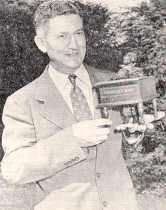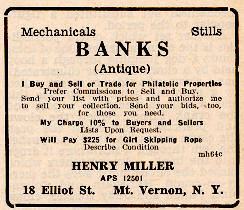| RELICS, The Magazine for Collectors, February, 1946 —
Pg. 19 - 21
YANKEE BANKS
by Douglas M. Fellows.
You might guess that Ben Franklin, after sitting up late one night to
write, "A penny saved is a penny earned," sharpened his quill and designed
the first mechanical bank. Or you might suppose that Carrie Nation
accomplished the trick between swings of the axe.
Anyone who ever heard ballads like "Father, dear father, come home to me
now" would be certain that Carrie would devise some means of keeping
Junior's little hoard safe from father when he got the urge for the demon
rum.
If
there were no way to get information about the inventor, your guess would be
as good as any other, and as a matter of fact the
experts are in doubt themselves. It may have been that the same practical
joker who produced the firecracker, devised the first mechanical bank, for
reposing in the Metropolitan Museum of Fine Arts is a porcelain bank you'll
be able to find only when you have three guide books, a battery of
attendants and perhaps the curator.
Anyway,
the description says that this bank was made
during one of those Chinese dynasties (it doesn't matter which one) which
were old and crumbling long before Nero got out of knee
pants. It must have been a joker who perfected this delicate
repository, as anyone will admit who ever dropped the family's prize tea
cup. But it was mechanical. The bear which graced the cover moved whenever
tickled by a piece of cash.
But
mechanical banks, as we know them, were a Yankee invention. Made for the
most part of cast iron, they reached a high degree of perfection and were a
popular Christmas or birthday present for more
than half a century.
As near
as the experts can figure it, John Hall, a native of New Hampshire,
dropped into the J. & E. Stevens Company of Cromwell one day in 1876 with a
mechanical bank pattern he wanted them to manufacture.
Naturally it took some time to carve a pattern in wood, secure the
patent and make the initial steps, but when the first bank was finished,
everyone knew it would be a success.
It was
a simple mechanism, merely a latch string
hung from the door of the toy house. When the string was
pulled the chimney cover popped open and a wooden image of a man
jumped up. The banks sold by the thousands and before long the Stevens
Company itself was designing new banks.
As with
anything which meets poplar approval, competition
soon developed, and the variety of banks which soon flooded the market
seemed numberless. As a matter of fact only about 230 varieties ever reached
the market, and there are no known existing models of some of them. But the
200 or more that can be collected offer a fine hobby for the person
interested in Americana.
Some of the mechanical
features of these banks are amazing. A wide variety of shooting banks
started with the Creedmore bank. This portrays a soldier
who shoots a coin into a tree trunk. The gun is operated by a tension
spring and the air is accurate. Later models using the same idea
portray William Tell, Teddy Roosevelt and an Indian shooting a bear.
Each model used the same mechanism but substituted
a figure popular to the period.
Another
set which offers possibilities is the carnival series. One of these shows a
dog jumping through a hoop held by a clown.
Another has a clown who rides in a cart pulled by a prancing pony. To
operate this one, a coin is
placed on a post and the crank turned. When the clown and prancing pony
reach the post, the clown raises his hand and pushes the coin through a slot
where it drops into the bank. Among others which caused the circus motif
were the merry-go-round, .Harlequin and columbine, Punch and Judy theater,
clown astride a ball, and dog jumping through a hoop.
Humorous subjects were very popular. Mark Haber, one of Hartford's two
outstanding collectors, enjoys his rare bank which shows a pig in a high
chair. It is one of the few toy banks to be nickel-plated. Most of them were
hand colored and Mr. Haber says the women who did this work Were paid a cent
for each bank they did.
Madame
Katzenjammer holding Hans and Fritz makes another humorous subject. The only
mechanical movement is in Mrs. K's. eyes, which roll when a coin is inserted
at the top of her head. Another subject,
Bill E. Grinn, rolls his eyes and sticks his tongue out, the tongue
extending further when a large coin is deposited.

Mark Haber, well known collector of
Mechanical Banks,
with a very rare Freedman Bank, one of the many in his
collection. Photo by Hartford Current Magazine
Some rare banks are valuable only from a collector's standpoint.
These banks are often not entertaining nor excellent from a mechanical
standpoint. No one seems to know why some more elaborate models are rare,
but collectors believe it is because the model either wasn't popular at the
time or cost too much to make. Madame Katzenjammer, for instance, although
of late manufacture is very rare, while the Hall bank is easily found in
good condition.
Another
rare bank of which Mr. Haber has a perfect specimen depicts a girl skipping
rope. This model is easily the outstanding mechanical bank. It is delicately
cast and perfectly made. A product of the J. & E. Stevens Company, it
probably sold for about $3.50, a good price in those days. This bank
operates by a spring mechanism. When wound, a coin is placed in a slot and
the lever sprung. The girl then begins to skip
rope. The figure is so arranged that she will jump off
the ground each time the rope passes under her feet; at the same time she
turns her head from side to side.
William
G. Downes, a well known Hartford dentist, is the other local collector. He
keeps an unusual display in his office. Perhaps his favorite is the dentist
bank illustrated. Here a darky is in the chair, the dentist's knee pressed
against his lap, ready to extract a tooth. The coin is put in the dentist's
pocket, and a lever released which throws both doctor and patient over
backwards. The change of position tosses the coin from the doctor's pocket
into the bank.
Another
rare bank in Dr. Downe's collection portrays Uncle
Remus stealing chickens. When the coin is placed in the slot, the bank is
open, portraying Uncle Remus in the open chicken coop door, a fowl in his
hand, while the cop stands at the side of the
coop, well out of sight. When released, Remus steps back,
the door slams and the officer whirls
around to the front of the coop. Naturally, the coin is also secured.
There
is a wide variety of these banks which caricature the Negro
— the Jolly Nigger Band, the Darktown Battery and I Always Did 'Spise
a Mule being among the most popular. The battery subject gives a great deal
of action. Here the pitcher throws a penny across the bank. The batter turns
his head and swings, missing the penny. The catcher moves his head :forward,
misses, and the coin falls into a slot in the catcher's body.
Another
bank that is still a lot of fun shows a Negro mammy who feeds a child the
penny, which has been placed on a spoon. The child swallows it, accompanying
the action by kicking its legs and showing other signs of objection.
From a
standpoint of rarity, possibly Mr. Haber's Red Riding Hood bank is the most
unusual in his collection. Only two are known to
exist and this one is not complete because a mask on which the grandmother's
face is painted, has been broken off. The action was arranged so that when
the lever was thrown forward to receive the coin, the mask was raised. This
exposed the wolf's face, frightening Red Riding Hood, who threw back her
head in fright.
The
trainer and bulldog and the man on the goat who feeds the bullfrog
are excellent examples of castings made by the I. B. Company of Buffalo.
Similarity of design shows them to be of common construction and the action
in each is deliberate and effective. In the first, the coin is held by the
trainer. When the lever is released, the bulldog jumps up, his mouth opens &
grabs the penny. As he flies back, the swallowed coin drops into the bank.
The second bank operates when the man and goat spring forward. The coin,
held by the man, slips into the frog's mouth, and the man and goat rebound,
ready for another coin. Both banks are operated by spring tension.
The
football players' bank is another bank with plenty of action. Insertion of
a coin releases a spring and the players move
forward in a rush, finally bumping their heads together. The stage is set
for another rush by moving the players into the first position, which
automatically cocks the mechanism.
Of all
the banks, one of the most , exciting from the standpoint of action is
Professor Pugfrog's Great Feat. In this bank the
activity is caused by spring action again. When wound, a coin is set on the
back of the bicycle and a lever released. The bicycle makes a complete
revolution, throwing the coin into the bank at one
end.
There
are so many types that it would be impossible to describe them all, but it
is impossible to discuss the hobby without mentioning the satirical banks.
Some poked fun at the Irish and others slurred politicians. The Tammany
Bank, also in another phase called the Boss Tweed Bank, was
the most common.
Although several iron foundries shared in the manufacture and design of
these banks, only the J. & E. Stevens Company is now in existence. Perhaps
this is because they also produced other types of iron toys, cap pistols
being the most, outstanding feature. As a matter of fact, they
incorporated the cap pistol idea into the banks, the Teddy Roosevelt
bank for instance, being so equipped. Although there was plenty of action in
the bank itself, a cap could be inserted in the
gun for an even better effect.
The
manufacture of these banks continued until the 1920's when new toys and new
ideas replaced them on the market. Sometimes a new model appears whose
history has now been completely lost, and several
common varieties are of unknown origin. Collectors are able to place some
models through old catalogues (themselves a hobbyist's item) and sometimes
by similarity of design.
There's
a word of caution necessary for anyone who remembers seeing one of these old
banks buried away in an attic. You may have a rare item and
then again it may
be just an interesting
curiosity. After all, any antique is worth only what you
can get for it and the people who save
banks do it for the love of the hobby rather than in hopes of making money.
Since this is true, you'd probably be more
interested in washing the dust from the eves of Professor Pugfrog
and giving him a chance to live again on your mantle where your
friends can enjoy his strange gyrations. Besides, he'll teach you to
save pennies just as well as he ever did.

|


